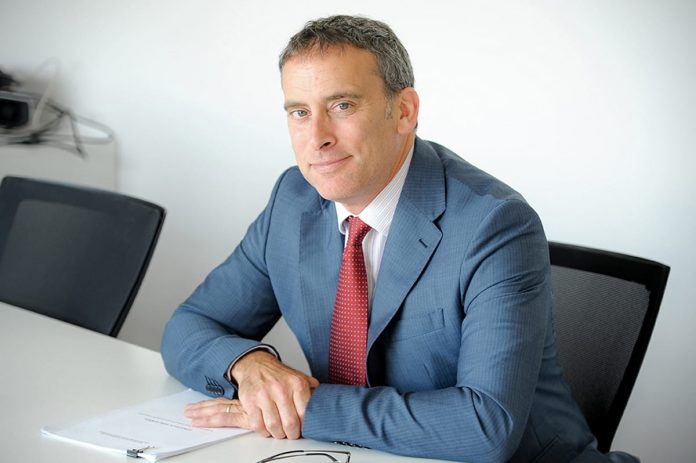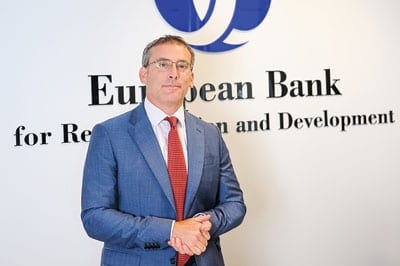
The European Bank for Reconstruction and Development (EBRD) was created 25 years ago, following the collapse of the Berlin Wall. The bank’s mandate was to help the countries of Central and Eastern Europe move from central planning to build market economies. The first project was approved in Poland. Following the political crisis in the former Yugoslavia, we opened our office in Belgrade in 2001 and our first project – a credit line with a local bank – was signed on 29th March that year. Since then we have invested around €4.3 billion in Serbia across all sectors of the economy – explains current EBRD Director for Serbia, Daniel Berg.
What have been the most historic moments marking the last 25 years since the establishment of the EBRD?
Certainly, the last 25 years have certainly been dramatic. We have witnessed new countries emerge and have responded to financial crises, as well as natural and manmade disasters. We have witnessed a move towards an innovative and green economy and, most recently, we have been addressing the fallout of demographic and migration trends.
Over this period, the EBRD’s remit grew dramatically, from the original eight borrowing nations to 36 countries today, including Mongolia, Turkey, the countries of the Southern and Eastern Mediterranean (SEMED) region and most recently Cyprus and Greece. One country (the Czech Republic) has “graduated” from being a country of operations; others would have followed by now, but the 2008 crisis brought new challenges for all of us.
The EBRD prides itself on being able to respond quickly where there are needs for our services. We played a key role in keeping the financial sector in Central and Southeastern Europe afloat after the 2008 crisis. We helped Ukraine diversify its energy supply and strengthen energy security last winter and have remained Ukraine’s largest foreign financier through the latest turmoil. We are the largest donor and manager of international donor funds for the New Safe Confinement in Chernobyl, which is nearing completion 30 years after the accident occurred on 26th April 1986.
The EBRD has supported renewable energy development across the region, both with policy advice and equity and debt financing. A third of our annual financing now goes to sustainable energy projects (in fact, we are ready to support wind farms in Serbia) and we aim to raise that to 40 per cent by 2020. We are working to support local currency lending and local capital markets and we were behind the issuance of the first bonds in local currencies in some of our countries. We also support female entrepreneurs in a dozen countries.
How much have the problems of emerging markets catered to by the EBRD changed; and what were the major historical and economic forces behind those changes?
Transition economies have experienced uneven development since the start of the transition. Some countries (especially in Central Europe and the Baltic) have taken major strides towards establishing well-functioning market economies. Others still face major transition gaps, with underdeveloped markets and economic sectors.
Opening up of the economies in CE and the Baltic region early on, with wide-scale privatisation and support for foreign direct investment (FDI), were important factors in their successful transition. These measures supported the transfer of cutting-edge technology and competitiveness. Strong ties to a large EU market, leading to full accession, also played a positive role in improving the investment climate.
The countries of the Western Balkans were, of course, impacted by violence and political unrest throughout the 1990s and thus reforms could only begin in earnest after the year 2000. Unfortunately, reforms have become more difficult following the 2008 financial crisis. Across the Bank’s countries of operations, we have seen a slowdown in reforms, and even less public support for reform, since 2008. It is important that each government continues with reform measures, so as to take advantage of their competitive potential.
How has the bank itself evolved, considering that it has gradually expanded its operations to a much larger part of the world than initially conceived?
The Bank has adapted to significant developments throughout the region and was asked by shareholders to expand its area of geographical operations. The EBRD’s business model stresses the need to support the development of competitive private businesses both directly and indirectly. A strong local presence (with offices at national and even regional level in larger countries) has helped the Bank achieve its objectives by providing local contacts and context so that we understand local developments better. Besides our traditional lending activities, which continue to develop, we have expanded our advisory services, both for small business and for government policies.
Which of those countries can today be considered fully open market economies?
If you look at the transition gaps we publish in each Transition Report, which is one of our flagship annual publications, you will see that CE and the Baltic had mostly caught up with advanced economies’ indicators by the early or mid-2000s. Other countries also, in general, advanced but in many cases, convergence slowed from the mid-2000s, except for the Southeastern Europe region, where transition started later due to the conflicts of the early 1990s.
There still remain large transition gaps in governance, enterprise restructuring and competition policy in the Western Balkans. That is why we focus our policy and technical assistance activities under our Investment Climate and Growth Initiative on these areas.

The EBRD prides itself on being able to respond quickly where there are needs for our services. We played a key role in keeping the financial sector in Central and Southeastern Europe afloat after the 2008 crisis
How does the EBRD’s Life in Transition Survey reflect those changes, when it comes to the expectations, hopes and fears of citizens across countries in transition?
We should not forget that much has changed and been achieved since the transition began in 1990. However, income gaps remain despite popular expectations that there would be a very rapid convergence towards developed countries following the fall of communism. This may contribute to a so-called “happiness gap”.
In our most recent Life in Transition survey, a lower share of households indicated “satisfied” with their lives compared to households in more advanced countries. Households in the transition region have been negatively impacted by the global financial crisis, as much as or more than their Western peers, with more job losses, wage reductions and reduced remittances. This “happiness gap” is a risk to popular support for democratic and market institutions, so it is important to continue reforms which will help economies converge with those of more advanced countries.
Large shares of the local populations are not supportive of privatisation. In some cases, this is due to badly managed privatisation processes and unfulfilled expectations. These findings reflect privatisation processes that were often strongly managed by special interest groups and, thus, the majority of the population did not see the benefits of the process. However, we do not believe that re-nationalisation or the state management of assets will lead to better results than through quality private managements.
Why did the hopes of some countries that their world would thoroughly change for the better after the fall of the Berlin Wall partly end up as illusions?
The success of economic reforms also depends on strong political institutions. Public institutions can ensure transparency, accountability, and quality governance of a state’s assets, but in many countries, these institutions remain weak and unable to effectively implement necessary economic reforms effectively (such as privatisations). Unfortunately, while growth has occurred, this growth has not been shared widely and large sections of society have not enjoyed the benefits.
How well is the transition to market economies followed by democratic changes; and how do you see the role of the EBRD in this part of your task?
The EBRD supports reforms that strengthen both democracy and economic efficiency. The EBRD believes that democratic and market reforms back each other and our experience supports this claim: the advancement of economic reforms, according to the EBRD’s transition indicators, is strongly correlated with the development of democratic institutions in the EBRD region. At the regional level, we have been pleased to promote regional cooperation. This has been highlighted most recently by the coming together of all Prime Ministers of the Western Balkans region at a conference held at EBRD headquarters in London, where they discussed the promotion of infrastructure and regional investment.
The EBRD is today also investing temporarily in Greece and Cyprus, in order to help them emerge from their deep economic crisis. How does the bank’s role there differ from its original focus on transition countries?
The EBRD is operating in both Greece and Cyprus on a temporary, time-bound basis. In both cases, the Bank has committed to be operational until the end of 2020, after which it will cease any new investments. In both cases, the Bank is using its expertise and knowhow to help these economies recover from deep crises. In this respect, the EBRD can play an important role by acting as a catalyst for fresh private investment and by helping to stabilise and strengthen the financial sectors of these countries.
To what extent are the countries of the Western Balkans that fell behind after the fall of the Berlin Wall still lagging behind their CE counterparts?
Western Balkan countries are still behind CE in most areas and sectors, but we should take into account the fact that they started the transition almost a decade later. GDP per capita in purchasing power parity terms is about half that of the CE region. Convergence, which was fast before the 2008-09 crisis, has slowed down significantly. That may be explained partly by the drop in investments seen since 2008 and the accumulated stock of FDI which is still below that of CE countries. Without additional investment, it will be difficult to catch up with more advanced countries.

We do not believe that re-nationalisation or the state management of assets will lead to better results than through quality private managements
How much have these countries been able to catch up with your support?
The EBRD focuses on closing the transition gaps through investments, easing access to finance constraints for the private sector and specifically for some groups (SMEs, women entrepreneurs), but also supporting institution-building and improving the business environment through technical and policy advice. Our investments in Western Balkans (Albania, Bosnia and Herzegovina, FYR Macedonia, Kosovo, Montenegro, Serbia) have reached €9.3 billion cumulatively (8.7per cent of the total EBRD investment to date) by year’s end 2015. About half of the investments have been in infrastructure, reflecting the largest gaps, with a fifth invested in energy.
Almost a year has passed since you became EBRD Director for Serbia. How have Serbia’s reforms progressed in the meantime?
I arrived in Serbia in August 2015 and have been impressed by the commitment to implement tough reforms, which have been backed by a credible IMF macroeconomic programme. Besides achieving macroeconomic targets, numerous measures have been taken, including legal reforms to streamline permits and labour issues; addressing some key obstacles to resolving banking sector non-performing loans (NPLs); initial restructuring measures at some large state-owned enterprises (SOEs); and measures aimed at reducing government bureaucracy through “rightsizing”.
These steps have led to an improved business climate (notable in the World Bank’s Doing Business ratings), but have also helped set the stage for the start of EU accession negotiations. The EBRD has responded by expanding our policy dialogue actions and last year we signed an MoU with the Government to implement at least 10 projects geared towards support improvements in governance and the investment climate. At the same time, the country cannot rest on its laurels. It is important to press forward with often difficult reforms, including privatisation and further restructuring. I look forward to working on these issues in the years ahead. I also hope that improving the business climate will create opportunities for EBRD financing for private investment.
What do you see as the major points of interest for the EBRD when it comes to Serbia?
As noted above, we would like to support increased private investment in Serbia. This can be foreign or domestic investors. We are looking at some interesting small companies and hope to work with them to support their growth to become national and perhaps international champions. Some partners and domestic companies are already becoming international champions – particularly in the agricultural and telecommunications sectors.
In the state sector, it is necessary to continue with restructuring measures. Last year we agreed to support EPS as it takes steps to improve its commercial standing. I look forward to working with the company and the government on implementation. Given relatively high debt levels, we need to work with creative financial structures – partnerships between the public and private sector – to develop important infrastructure.
Finally, I see deep opportunities to utilise the EBRD’s experience in supporting the Green Energy Transition in Serbia. We are prepared to support private and state companies in reducing their carbon footprint. We are seeking to improve efficiency in areas of the municipal sector – such as lighting, buildings and water distribution. We also expect to support the growth of renewable energy production in Serbia, which is just in its initial stages.